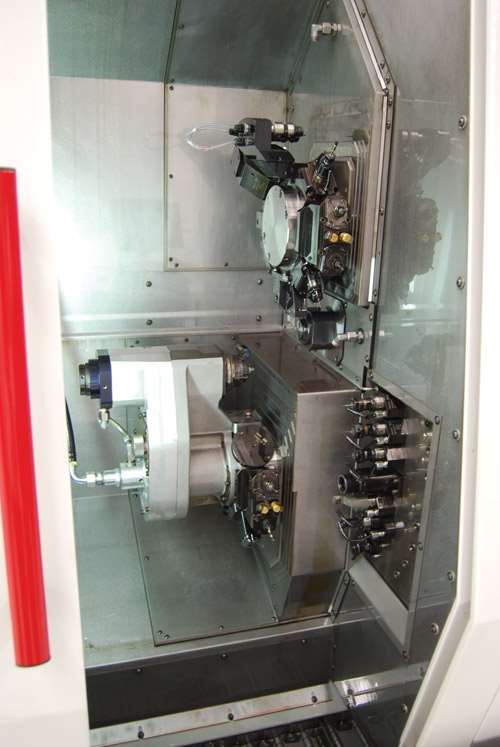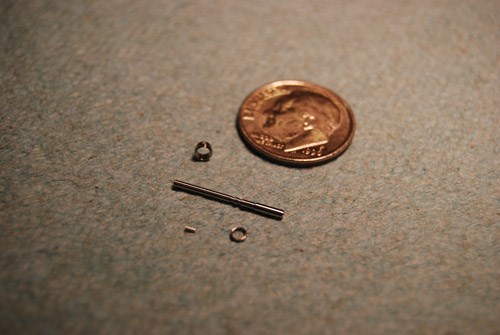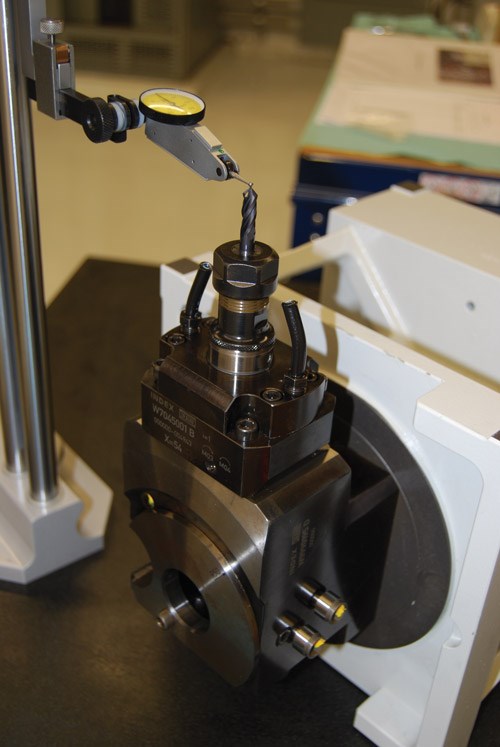Manufacturing Medical Devices for Today and Tomorrow
The pace of change in medical device design and manufacturing is rapid and is fueling demand for machine tool capability that not only reduces cost per piece today, but can open doors to producing new types of parts in the future.
Oscor Inc., Palm Harbor, Fla., already a successful medical device manufacturer, knows that change is inevitable and has taken strong steps to stay ahead of the curve. The company designs, develops, manufactures and markets a variety of highly specialized permanent and temporary pacing lead systems.
Featured Content
To produce the leads, the company recently opened its new tool shop and engineering facility, which adds 50,000 square feet of precision tool and mold shop, Swiss machining and other manufacturing capacity. One of the newest machines in the shop is an Index Traub TNL18 sliding/fixed headstock production turning machine.
Thomas Osypka, president and CEO, pointed out that the company has been doing Swiss machining for more than 10 years and that the parts it makes are becoming more complex and smaller than ever. “We found that our current machines were not going to be able to handle these new parts in a single operation. We looked around for a machine that could do our parts in a short cycle time in one operation. The new TNL18 met our requirements,” he says.
The company’s pacing leads are used in connection with pacemakers, both implantable and temporary pacemakers systems, that are used to treat cardiac bradyarrhythmias (an adult heart rate below 60 beats per minute) and other coronary disorders.
Oscor’s proprietary lead technologies have also sparked the development of new lead systems for a variety of cardiac and non-cardiac (nerve) applications. These include catheters and introducers (for introducing a drug or other substance into the body).
Through a clear focus on product quality and innovation, Oscor has established a strong market position in the United States and internationally. It sells its products in more than 65 countries outside the United States and is relied on by medial OEMs to deliver perfection every time.
A One-Stop Shop
Oscor handles the entire process in-house, from component design to mold building, component manufacturing and sterile packaging and labeling. On its higher volume parts, the company produces in the range of 100,000 parts per month. Typical tolerances are 0.0002 inch and most parts are less than 0.25 inch diameter, many are almost too small to see.
Mr. Osypka justified the purchase of the new turning machine partly as a new business tool, allowing the company to design lead parts that have never been created before. A new design lead contact concept would provide a range of advantages over a conventional contact. But the design could not be produced on the existing machines at Oscor nor by other outside sources.
In its first setup at Oscor, the turning center defeated a previous setup for a high-nickel, chrome and molybdenum part by 3-to-1 in a less than a 500-piece run. “We see the possibility for even better results as the capabilities of the machine are fully utilized by a well trained operator,” says Udo Wollmann, Oscor’s director of operations.
And as the company loads part programs for current production into the Traub, it is also finding that the convertible machine is able to reduce cycle times on those parts by up to 40 percent part-for-part compared with its current equipment.
“This magnitude of cycle time improvement proves that the machine will be a very worthwhile investment,” Mr. Osypka says.
Learning by Doing
To date, Oscor is finding that the turning center allows the company to optimize every facet of production, minimize tool wear and reduce cycle time. This is due in part to the training from the machine tool builder and also that the builder helped Oscor identify ways to make its parts more efficiently, Mr. Wollmann reports. As Oscor works with the machine, it is also able to improve its yield of usable parts.
The TNL18 gave the company the ability not only to run its current parts faster than previously, but also allowed the company to pursue the production of parts they had been unable to produce on current machines, because of a greater number of axes and more tooling options. “We need the extreme flexibility in order to be a leader in our industry and to quote parts we may not have had a chance to quote earlier. This also opens opportunities for us to discuss new possibilities with potential customers,” Mr. Wollmann says.
Compared with other Swiss turning machines that the company runs, this one has the capability to be used as a milling center, because of the range of tooling and axes it features. According to Mr. Wollmann, “Milling data is the same on this machine as on the company’s milling centers, plus you have the option of orienting the part to the tool in many different ways, facilitating chip clearance and reducing cycle time.”
As a lathe, the machine also allows the company to run a part from barstock rather than milling blanks, saving a great deal of processing time on those parts. Oscor can also decide not to use the bar feeder when producing shorter runs and extreme tolerances to 0.02 microns.
“With a complex machine like this, you need to be a little bit broader minded than you might be with a typical Swiss machine because of the range of capabilities it brings to the parts,” Mr. Wollmann says. “This machine does operations I never thought of putting together—that’s what I like about it. I have a pretty good imagination, and I don’t see the end of what we can do.
“By the same token, it has to become part of your process planning to fully use the capabilities and improvements the Traub offers. You cannot process the same old way if you want better results.”
Programming and Simulation
Paired with the machine is the company’s Winflex programming and simulation software, which allows the programmer/operator to simulate tool paths and optimize the programs prior to running parts. Index provided extensive training for the operator on the machine and the simulation programming. With its 2D or 3D simulation that can run backwards and forwards parallel to the program creation, WinFlexIPS is an easy to learn program creation option.
The software permits the parallel programming and depiction of as much as four subsystems with simultaneous simulation of the machining, as well as numerous functions for creating, checking and optimizing the machine process, including a range of functions and cycles and clear presentation of all parts systems. Through user-oriented operating controls, part data is input through WinCAD.
“This software is very easy to use,” the machine operator says. “Its tools allow me to do in minutes what would take me hours with paper and a calculator—and I have years of experience. We prefer offline programming so as not to interfere with our production. 3D simulation also allows us to avoid interference in the machining process. We have done a few parts already where I have been able to cut the cycle time in half compared with what we run on the other machines because of the machine’s versatility. I can do overlaps and crosses that typical machines cannot.”
Oscor has been loading part programs into the Traub, trying them out first in WinFlex. The operator is finding setup of parts and machining cycle times to be faster, which will become an even better advantage as parts see higher production volumes. “We are investing into what our future is going to become,” says Kevin Wade, tool shop supervisor.
“The only limitation to what you can accomplish on the Traub is in your mind, because there is so much there: three tools in the cut at a time; subspindle work running simultaneously with four-spindle work (both spindles at the same time) means there is a lot going on in the machine at all times,” the operator says.
The machine is capable of multiple machining functions, including milling. And the rigidity of the machine’s construction is well suited to machining micro-parts in the tough material Oscor uses, including titanium and special steel alloys. The tool positioning is almost unlimited, allowing Oscor programmers to rapidly put the tool points where required.
Machine Convertibility
Oscor also likes the convertibility of the TNL from sliding to fixed headstock, which saves production time and dramatically increases the versatility of the machine for the company and the many different parts it produces.
The machine can be changed over in minutes to produce precision parts with or without a guide bush for long or short parts from bar up to 20-mm diameter. The extremely long Z-travel distance of the headstock ensures the proper positioning of the main spindle, either for turning with a guide bush or without.
A swiveling subspindle is fitted to an XYZ cross-slide, which at the same time carries the bottom tool turret. This slide, with large axis travel distances, provides plenty of space for three-axis reverse side machining, even for geometrically complex
workpieces.
The tool capacity of the TNL18 can be increased to as many as 54 tool places through dual- and multi-holders of live and fixed tools, which enables extending production time. The high-speed turret indexing permits a chip-to-chip time of only 0.3 of a second. The solid backworking attachment accommodates seven toolholders, of which three can be driven.
A new concept in tool carriers uses a NC rotary axis without mechanical interlock to permit complete freedom of tool positioning. The tool can be positioned where needed for any machining operation, offering unparalleled processing flexibility.
One-to-One Tool Setting Saves Time
The machine also came with a tool setting station. “Using the fixture, I can emulate what is in the machine, adjusting the tool with only two screws rather than in the machine to set the offset,” the operator says. “The relationship to the machine is one to one.” The different sides of the setting fixture equal each different toolholding situations on the machine.
All toolholders are seated deeply in the turret, which results in less leverage effect and, therefore, high stiffness. A quick-change system enables a high precision, smooth exchange of tools without removing the tool holder. The machine’s compact shaft system dramatically increases tool life and contributes to improved surface quality.
The working area of the TNL18 is easily accessed by the user through a high and wide sliding door. This provides a lot of room for operators to easily reach the tools and spindles. A large inspection window allows the operator to keep a close eye on the machining process.
According to Mr. Osypka, “We will continue to invest in our employees, systems and technology to support our mission of providing physicians the tools necessary to improve patient outcomes, while reducing recovery times and treatment costs. We believe the Traub machine is an important tool in accomplishing our mission today and into the future with components that have not yet been invented.”
RELATED CONTENT
-
Femtosecond Laser Processing in the Medical Device Industry
Recent advances in the laser technology have brought improved capabilities for precision machining—no thermal effects and minimal post processing.
-
VIDEO: Swiss Shop’s Choice of Collets Facilitates Backworking
This Swiss shop discovered workholding collets that satisfy the needs of its very small, delicate and complex medical parts production on the subspindle, making once impossible processes not only doable but more efficient and esthetically pleasing.
-
Advancements in Thread Whirling Tooling Technology
Many understand the advantages of thread whirling on a CNC Swiss-type. However, new tooling technology for this thread-machining process can further improve cycle times and reduce cost per part.











